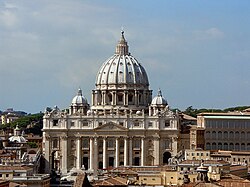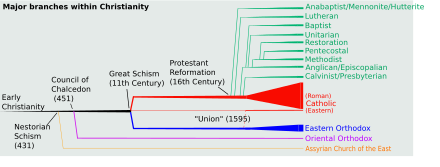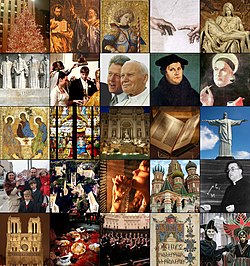Western Christianity
| Part of a series on |
| Christianity |
|---|
 |



Western Christianity is one of two subdivisions of Christianity (Eastern Christianity being the other). Western Christianity is composed of the Latin Church and Western Protestantism, together with their offshoots such as the Old Catholic Church, Independent Catholicism and Restorationism.
The large majority of the world's 2.3 billion Christians are Western Christians (about 2 billion – 1.2 billion Latin Catholic and 800 million Protestant).
The establishment of the distinct Latin Church, a
Western Christianity has
Today, the geographical distinction between Western and Eastern Christianity is not nearly as absolute as in Antiquity or the Middle Ages, due to the spread of
While the Latin Church maintains the use of the Latin liturgical rites, Protestant denominations and Independent Catholicism use a wide variety of liturgical practices.
The earliest concept of Europe as a cultural sphere (instead of simply a geographic term) appeared during the Carolingian Renaissance of the 9th century, which included territories which practiced Western Christianity at the time.[9]
History

For much of its history, the Christian church has been
Like
With the
Over the centuries, disagreements separated Western Christianity from the various forms of Eastern Christianity: first from
Historian Paul Legutko of Stanford University said the Catholic Church is "at the center of the development of the values, ideas, science, laws, and institutions which constitute what we call Western civilization".[13] The rise of Protestantism led to major divisions within Western Christianity, which still persist, and wars—for example, the Anglo-Spanish War of 1585–1604 had religious as well as economic causes.
In and after the Age of Discovery, Europeans spread Western Christianity to the New World and elsewhere. Roman Catholicism came to the Americas (especially South America), Africa, Asia, Australia and the Pacific. Protestantism, including Anglicanism, came to North America, Australia-Pacific and some African locales.
Today, the geographical distinction between Western and Eastern Christianity is much less absolute, due to the great migrations of Europeans across the globe, as well as the work of missionaries worldwide over the past five centuries.
| Part of a series on |
| Christian culture |
|---|
 |
| Christianity portal |
Features

Original sin
Filioque clause
Most Western Christians use a version of the
Date of Easter
The date of Easter usually differs between Eastern and Western Christianity, because the calculations are based on the Julian calendar and Gregorian calendar respectively. However, before the Council of Nicea, various dates including Jewish Passover were observed. Nicea "Romanized" the date for Easter and anathematized a "Judaized" (i.e. Passover date for) Easter. The date of observance of Easter has only differed in modern times since the promulgation of the Gregorian calendar in 1582; and further, the Western Church did not universally adopt the Gregorian calendar at once, so that for some time the dates of Easter differed between the Eastern Church and the Roman Catholic Church, but not necessarily as between the Eastern Church and the Western Protestant churches. For example, the Church of England continued to observe Easter on the same date as the Eastern Church until 1753.
Even the dates of other Christian holidays differ between Eastern and Western Christianity.
Lack of essence–energies distinction
Eastern Christianity, and particularly the Eastern Orthodox Church, has traditionally held a distinction between God's essence, or that which He is, with God's energies, or that which He does. They hold that while God is unknowable in His essence, He can be known (i.e. experienced) in His energies. This is an extension of Eastern Christianity's apophatic theology, while Western Christians tend to prefer a view of divine simplicity, and claim that God's essence can be known by its attributes.
Western denominations
Today, Western Christianity makes up close to 90% of Christians worldwide with the Catholic Church accounting for over half and various Protestant denominations making up another 40%.

Major figures
Bishop of Rome or the pope
Relevant figures:
- Clement of Rome(fl. c. 96), one of the apostolic fathers of the church.
- Pope Leo I
- Gregory the Great
The Reformers
Relevant figures:
- Jan Hus (c. 1369–1415), one of the most relevant theologians in the 14th century.
- Martin Luther (1483–1546), the most famous reformer and theologian in the Reformation and in the 15th century.
- Hans Tausen, Bishop of Ribe (1494–1561), leading theologian of the Reformation in Denmark and Holstein.
- Gustav I of Sweden.
- Slovenian language.
- John Calvin (1509–1564)
- John Knox (1514–1572)
- Ferenc Dávid (1520–1579) founder of the Unitarian Church of Transylvania who laid the foundation for what would become the nontrinitarian movement.
- Mikael Agricola, bishop of Turku (1554–1557), he became the de facto founder of literary Finnish and a prominent proponent of the Protestant Reformation in Sweden, including Finland, which was a Swedish territory at the time. He is often called the "father of literary Finnish".
Archbishop of Canterbury and primate of all England
Relevant figures:
- Augustine of Canterbury (597–604)
- Thomas Cranmer (1533–1555), one of the major reformers in England
- Matthew Parker (1504–1575),(Parker was one of the primary architects of the Thirty-nine Articles)
Archbishop of Lyon and primate of the Gauls
Relevant figures:
- Irenaeus of Lyon (died c. 202)
Patriarch of Aquileia
Relevant figures:
See also
- Aristotelianism
- Augustinianism
- Bohemian Reformation
- Calvinism
- Latin Church Fathers
- Ecclesiastical differences between the Catholic Church and the Eastern Orthodox Church
- Holy Roman Empire
- List of Christian denominations
- Neoplatonism
- Radical Reformation
- Scholasticism
- Swiss Reformation
- Theological differences between the Catholic Church and the Eastern Orthodox Church
- Thomism
- Western culture
- Western religions
References
- ^ "CATHOLIC ENCYCLOPEDIA: Agnus Dei (In Liturgy)". www.newadvent.org. Retrieved 2 January 2024.
- ^ Centre, UNESCO World Heritage. "Vatican City". UNESCO World Heritage Centre. Retrieved 2 January 2024.
- ^ Center, Pew Research (19 December 2011). "Global Christianity - A Report on the Size and Distribution of the World's Christian Population". Pew Research Center's Religion & Public Life Project. Retrieved 1 February 2024.
- ^ "Distinguishing the terms: Latins and Romans". Orbis Latinus.
- ISBN 978-1-111-83169-1 – via Google Books.
- ^ "Roman Catholicism". Encyclopædia Britannica. 11 August 2023.
Roman Catholicism, Christian church that has been the decisive spiritual force in the history of Western civilization.
- ^ Hayas, Caltron J.H. (1953). Christianity and Western Civilization. Stanford University Press. p. 2.
That certain distinctive features of our Western civilization—the civilization of western Europe and of America—have been shaped chiefly by Judaeo – Graeco – Christianity, Catholic and Protestant.
- ^ Orlandis, José (1993). A Short History of the Catholic Church. Four Courts Press.
- ^ Dr. Sanjay Kumar (2021). A Handbook of Political Geography. K.K. Publications. p. 127.
- ^ "General Essay on Western Christianity", Overview Of World Religions. Division of Religion and Philosophy, University of Cumbria. © 1998/9 ELMAR Project. Accessed 1 April 2012.
- ISBN 978-0-19-280290-3.
- ^ "Pentarchy | Byzantine Empire, Justinian I & Justinian Code | Britannica". www.britannica.com. Retrieved 2 January 2024.
- ^ "Review of How the Catholic Church Built Western Civilization by Thomas Woods, Jr". National Review Book Service. Archived from the original on 22 August 2006. Retrieved 16 September 2006.
- ISBN 978-0-88141-144-7 – via Google Books.
- ISBN 978-0-8262-1567-3.
- ISBN 978-0-9833480-1-6 – via Google Books.
- ISBN 978-1-4681-2984-7 – via Google Books.
- ^ Cross 1966, p. 994.
- ISBN 978-0-88489-725-5.
- ^ "Trubar Primož". Slovenian Biographical Lexicon. Slovenian Academy of Sciences and Arts. Archived from the original on 4 November 2013. Retrieved 25 April 2013.

